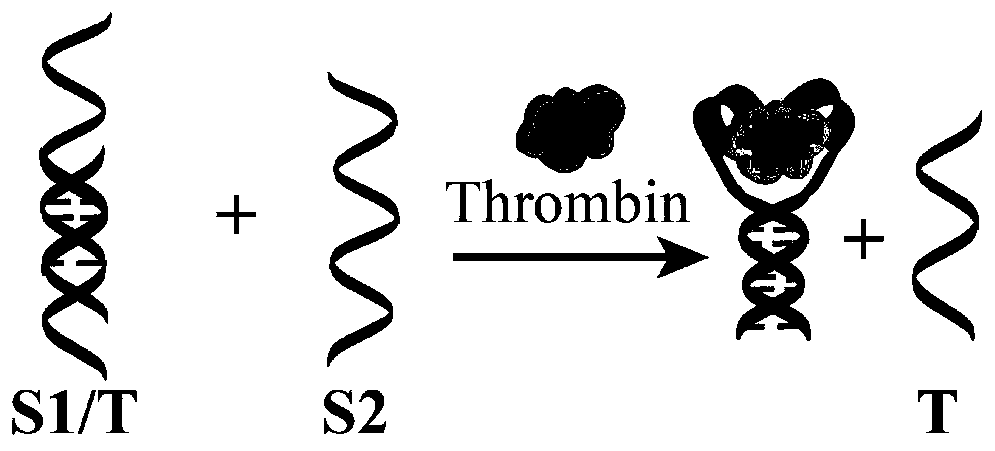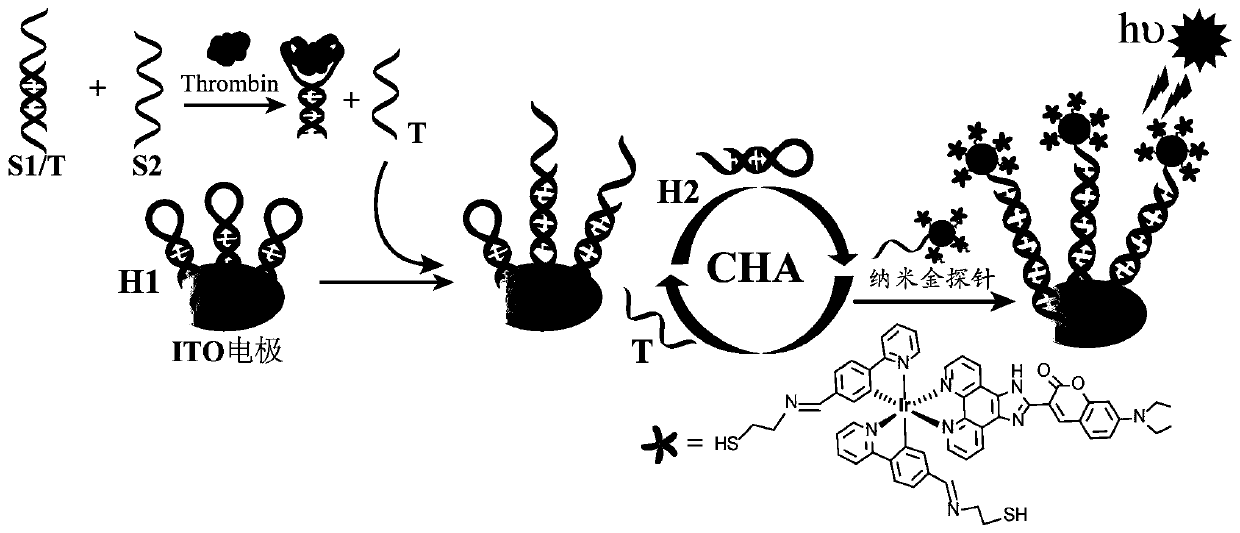Preparation method of thrombin photoelectrochemical sensor based on cyclometalation Ir(III) coordination compound
A photoelectrochemical and thrombin technology, applied in biochemical equipment and methods, microbial measurement/inspection, etc., can solve the problems of insufficient sensitivity, specificity, background fluorescence interference, high instrument cost, etc., and achieve improved detection sensitivity, photoelectric High conversion efficiency and improved specificity
- Summary
- Abstract
- Description
- Claims
- Application Information
AI Technical Summary
Problems solved by technology
Method used
Image
Examples
Embodiment 1
[0035] Synthesis of Ir(III) Complex Photoelectric Materials
[0036] (1) Take 7-diethylamino-3-formyl coumarin (127.9mg, 0.68mmol), 1,10-phenanthroline-5,6-dione (104.1mg, 0.5mmol), ammonium acetate ( 805.4mg, 11.3mmol), put into a round bottom flask, add 13mL of glacial acetic acid to dissolve, heat and reflux for 6h under the protection of nitrogen, stop heating after observing that the raw material gradually turns orange, and let it cool naturally. Add concentrated ammonia water to the mixture to adjust the pH to about 7 to obtain a pink precipitate, which is filtered and washed with water. The sample is vacuum-dried overnight, and the crude product is purified by column chromatography (dichloromethane:methanol=8:1) to obtain a milky white solid product as Cyclometallic ligands, vacuum-dried at 60°C, weighed 0.105g, yield: 71%. 1 H NMR (500MHz, CDCl 3 ):δ=9.16(d,J=4.2Hz,2H), 8.99(s,1H),8.78(d,J=5.8Hz,2H),7.70-7.72(m,2H),7.51(d,J= 8.0Hz, 1H), 6.68(dd, J=2.0, 7.0Hz, 1H), 6...
Embodiment 2
[0040] Preparation of Nanogold Probes of Cyclometallic Ir(III) Complexes
[0041] (1) Preparation of nano-gold: Wash the glass instruments, magnets and containers for storing nano-gold particles required in the preparation process with secondary water, soak overnight with aqua regia, and then rinse with a large amount of ultrapure water to pH The value is neutral, dry for later use. Chlorauric acid HAuCl 4 (1.0mmol / L, 100mL) was placed in a cleaned single-necked flask while stirring and heated to boiling, then quickly added trisodium citrate (38.8mmol / L, 10mL) to the above solution, and continued to react for 10min. Slowly turn into deep wine red, continue to reflux for 15 minutes, stop heating, and naturally cool to room temperature while stirring, take 500 μL of gold colloid solution for centrifugal washing (10000 rpm, 10 minutes), and evenly disperse in 1 mL of 0.02% SDS solution for later use.
[0042] (2) Take 1.5 μL tris-HCl (0.5M, containing 0.1M NaCl, pH=7.4), 6 μL 1...
Embodiment 3
[0044] Preparation of photoelectrochemical sensor based on iridium complex gold nanoprobe prepared in example 2
[0045] (1) Preparation of the working electrode: The ITO electrode was ultrasonically cleaned with acetone, ethanol, and ultrapure water in sequence, and then dried under a nitrogen atmosphere. Immerse the cleaned ITO electrode in 30% H 2 o 2 ,NH 4 OH and H 2 O (volume ratio 1:1:5) mixed solution for 15 minutes, took out and rinsed with ultrapure water, and dried under nitrogen flow. Then immersed in 5% APTMS ethanol solution overnight. Wash thoroughly with ethanol and dry at 110°C for 15 min. Immerse in the AuNPs solution and incubate for 12 h to obtain the electrode surface modified with gold nanoparticles. After cleaning with ultrapure water and drying under nitrogen flow, use 3M invisible tape to control the ITO electrode area to 0.5 cm × 0.5 cm. The pre-activated hairpin DNA HP1 solution (1.0 μM, 20 μL) with a sulfhydryl group was added dropwise to the ...
PUM
 Login to View More
Login to View More Abstract
Description
Claims
Application Information
 Login to View More
Login to View More - R&D
- Intellectual Property
- Life Sciences
- Materials
- Tech Scout
- Unparalleled Data Quality
- Higher Quality Content
- 60% Fewer Hallucinations
Browse by: Latest US Patents, China's latest patents, Technical Efficacy Thesaurus, Application Domain, Technology Topic, Popular Technical Reports.
© 2025 PatSnap. All rights reserved.Legal|Privacy policy|Modern Slavery Act Transparency Statement|Sitemap|About US| Contact US: help@patsnap.com



